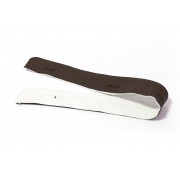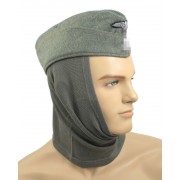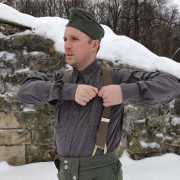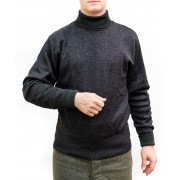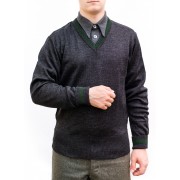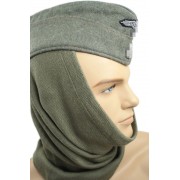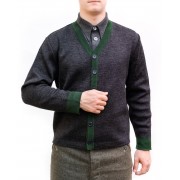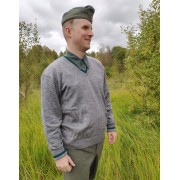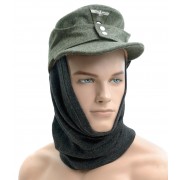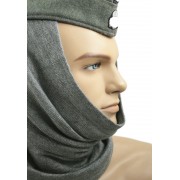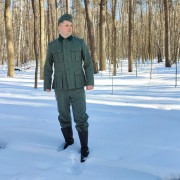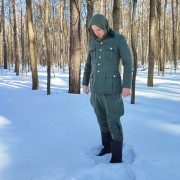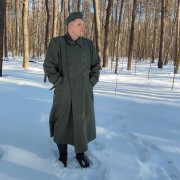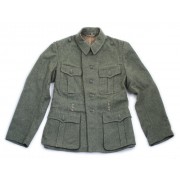How to choose the size?
The original sweaters came only in three sizes: I (small), II and III (large). We have made them in a modern size grid, so that you can better choose the size for yourself. For those who do not compromise and want to wear exactly I, II, or III, we have indicated the correspondence in the table.
In the photo, you can see a person with a chest circumference of 90 cm, shoulder width (according to the t-shirt) of 48 cm. He fits a size 50, which he wears.
To measure the length and volume you need a flexible meter, or at least a string. It can be compared with any sweater or shirt that you have and suits you.
• Chest — the girth of a bare chest recommended for a given size; the size in brackets is the width of the chest on the sweater laid on the floor.
• Shoulders — shoulder width across a sweater lying flat on the floor.
• Sleeve — the length of the sleeve from the shoulder seam, including the cuff.
• Length — the length of the sweater on the back. There are no other lenght-sizes!
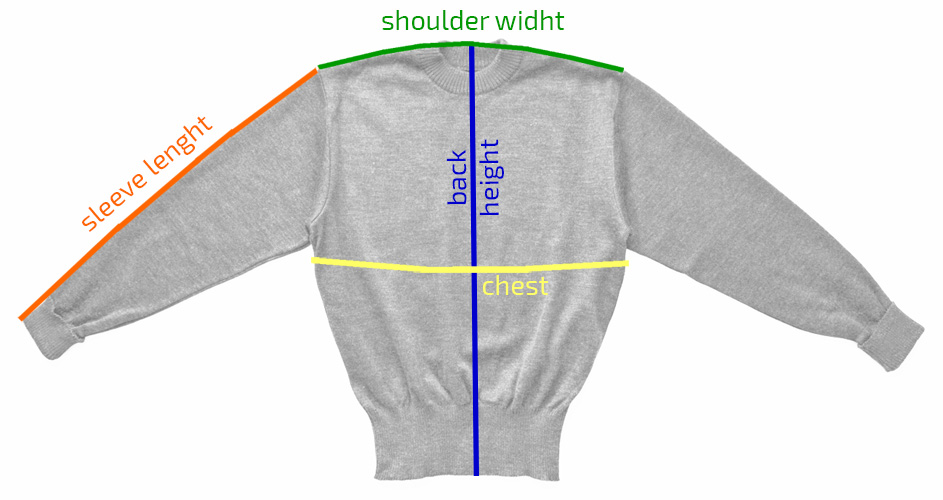
The main size of a sweater is shoulder width + sleeve length. You need to choose a size so that the sum of the lengths (sleeve + shoulders + other sleeve) suits you. Other sizes are either dependent on these or given for reference.
| Russian size | German size | Chest flat / around, cm | Shoulders, cm | Sleeve, cm | Lenght, cm |
| 48 | I | 54 / 96 | 49 | 67 | 64 |
| 50 | - | 55 / 100 | 49 | 68 | 65 |
| 52 | II | 57 / 104 | 50 | 69 | 65 |
| 54 | - | 58 / 108 | 50 | 70 | 67 |
| 56 | III | 60 / 112 | 51 | 71 | 68 |
| 58 | - | 61 / 116 | 51 | 72 | 69 |
If you do not understand the table and you need help, write or call us, we will help you find the size.
You can choose and put in the basket only the sizes in stock. If the desired size is not available, then it is currently out of stock. It may appear later.
Description
A copy of the standard German army sweater from World war II with a O-shaped neck opening. The cuffs are 12 cm long and are designed to be worn doubled up. A 10 cm wide elastic band at the bottom presses the sweater against the trousers. The color is dark, not ashy; the wool is melange (that is, it consists of fibers that are different in hue: lighter, darker). There are cold green stripes on the collar and cuffs.
Composition 50% wool + 50% acrylic. Thanks to its composition, the sweater keeps its shape well and serves for a long time, it can be washed in the washing machine (in the "wool"mode).
For those who think that 50% of wool in the product is not enough:
1) 100% wool can not be washed in the mashine. Only hand wash in cold water, drying in the straightened form, the products are "one-use".
2) When you are told about 70% or 90% of the wool in the product, it is most likely not true. You can determine the amount of wool only by the factory marking on the yarn (which is confirmed by certificates), from which the product is then woven. And vice versa, it is impossible to determine the % of fibers by eye or by improvised means, for this purpose a laboratory analysis is needed. You can only tell if there are supplements or not. But they can write any "nice" % of wool in the ad, so it is stupid to believe this.
We honestly report the composition of the fiber by marking on the yarn.
Historical reference.
The sweater appeared in 1936 under the original name Schlupfjacke 36 (literally translated from German: "sliding jacket", which corresponds to the English "pullover"; the Germans call camouflage blouses with lacing on the chest also Schlupfjacke).
The first sweaters had the V-neck (German: V-Ausschnitt) and were decorated with a green or grey stripe along the collar and cuffs. The green color was usually cold, close to the Abzeichentuch (dark green cloth for insignia) pattern of the 1935 (order HV35 No. 505). A grey sweater with dark green stripes was combined with grey trousers from 1922/36 and the field jacket collar in the dark green colour, with patches on the dark green field.
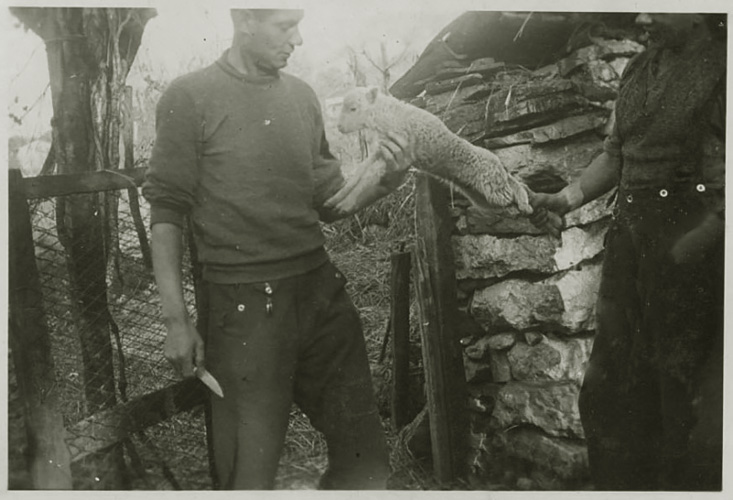
Over time (after 1940), the color of the wool became darker, mixture contained less wool, the decorative stripes disappeared (and the dark green color in the uniform was abolished). Sweaters with a round collar appeared, this covered the chest from the cold better, as well as a high "turtle-neck" collar that covered the neck. In the photo above, decorative stripes are present on the sweater with a round neck.
The sweater is not visible under the uniform, so it is difficult to trace its use by original photos. But it was popular in the military, as it was light and warm. Sweaters were treated with a compound against insects (lice). Also disinfection (roasting) of clothing carried out periodically. However, in the difficult conditions of positional fighting, it was not possible to avoid the appearance of lice, and they lived in the cavities of woolen products...
The sweater wasn't big. On the contrary, according to the fashion of the time, it was compact, the elastic band barely reached the hips, and the cuffs bared the wrists if you bent your arm. This is clearly visible in the photo above. To a modern person, this style may seem "small", however, this is how clothes were worn in the German army of the early XX century.
There were only three sizes, which is justified for the purposes of global economy for loose or shapeless clothing (such as a sweater, a loose shirt, camouflage). Usually the size was indicated by a small woven label on the back inside of the collar.
Historical information is taken from books "Feldbluse", L. Huart, J.-Ph. Borg; "Deutsche Soldaten" A. Sáiz and websites en.wikipedia.org, reibert.info.










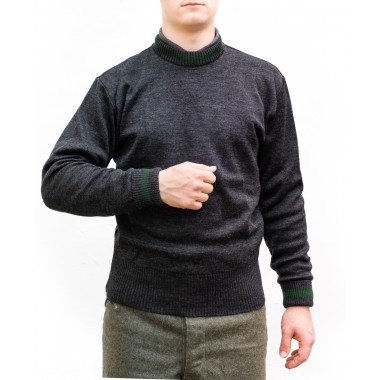









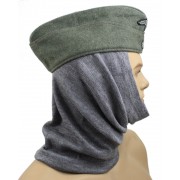
![[on order] Field blouse M36 with insignia [on order] Field blouse M36 with insignia](https://reenact.store/image/cache/afacfb9c74f543ca7f1a1e7285365560.jpg)
